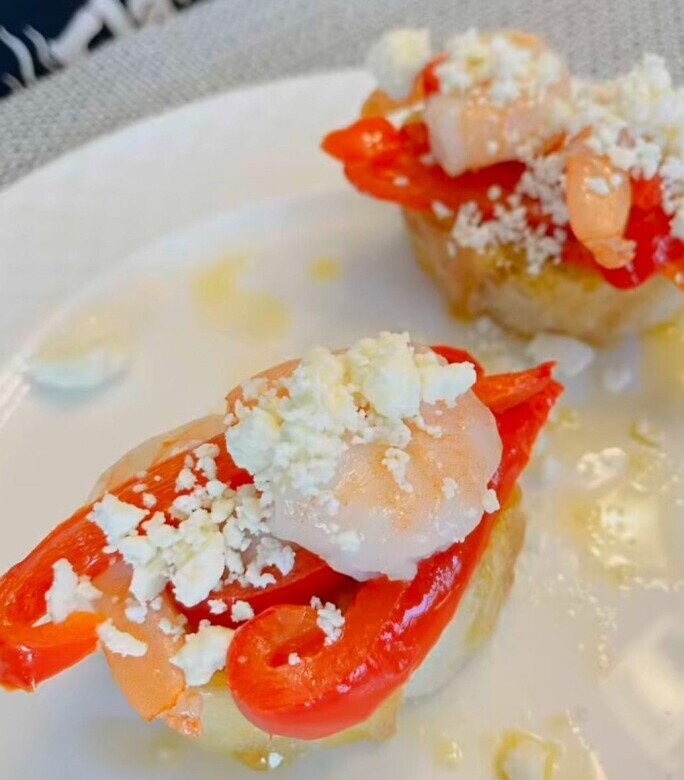Venezuelan Peppers and Shrimp
***Jump to Recipe***

Venezuelan peppers bring a vibrant splash of color and flavor to the kitchen. These peppers have roots deep in the soil of indigenous cultures long before Venezuela was even on the map. With such rich history, they’ve seen it all – migrations, trade routes, you name it. The peppers are a fundamental piece of the puzzle in the culinary arts down in Venezuela, adding not just spice but stories to the dishes.
The growing conditions in Venezuela are an absolute dream for these peppers. A lot of sunshine, consistent rainfall, and a diverse ecosystem contribute to the robust varieties found across the region. Whether nestled in small backyard plots or sprawling across larger fields, these peppers thrive and become a staple in the local markets.
When it comes to shrimp, the Venezuelan coastlines offer a cornucopia of these delicious creatures. Imagine the first fishermen, casting their nets into the waters, pulling up shrimp that quickly became a beloved ingredient in the kitchens. They’re not just food; they’re part of the maritime culture that defines parts of Venezuela.
The geography and climate have played a big role in shaping how peppers and shrimp are consumed in Venezuela. With varied terrains from the Andean rainforests to Caribbean beaches, access to diverse ingredients is just a given. This blend of land and sea influences what ends up on the dinner tables, creating food that’s rich in character and flavor.
Venezuelan Peppers and Shrimp: A Culinary Tradition
When peppers meet shrimp in the heart of Venezuelan kitchens, magic happens. These ingredients combine to create dishes that are more than just meals—they’re experiences passed down through generations. Signature recipes like ‘camarones al ajillo’—a sizzling garlic shrimp dish—feature prominently, showcasing the harmonious marriage of heat and savoriness that peppers and shrimp offer.
Every Venezuelan family has its own take on beloved recipes, tweaking them to match their personal taste and adding unique touches. The result? A rich tapestry of flavors and culinary styles that celebrate local ingredients and creativity. It’s in these family gatherings, where stories are shared over a pot of ‘pabellón criollo’ with a vibrant pepper salsa on the side, that food truly becomes a cultural touchstone.
Beyond their taste, these dishes carry deep-seated cultural significance. When families gather, it’s not just about eating. It’s about connecting with loved ones and the past—a way to keep culture alive through every bite. Dishes like ‘asopado de camarones’, a hearty shrimp stew, mark life’s significant moments and holidays, bringing family and friends around the table to share in the joy.
Peppers and shrimp in Venezuela stand as symbols—not just of adaptation and resilience, but of a people who celebrate life through their food. As you explore these flavors, you’re not just indulging in a culinary delight; you’re participating in a tradition that honors the heart and soul of a country.
Celebrating with Flavor: Traditions and Holidays Featuring Peppers and Shrimp
In Venezuela, peppers and shrimp don’t just satisfy appetites—they star in lively celebrations and cherished traditions. You’ll find them on plates during key festivals and holidays, adding a spicy kick and a touch of the ocean to traditional spreads. From National Independence Day fiestas to local town festivals, these ingredients turn routine meals into festive feasts.
One standout celebration is the annual “Feria del Ají”—a festival dedicated to peppers. Here, local varieties like the ‘ají dulce’ pepper take center stage, with cooking competitions and tastings galore. It’s a time when culinary experts and home cooks alike flaunt their skills, crafting dishes that spotlight the pepper’s diverse flavors and potent heat. After all, what’s a Venezuelan party without a little fire?
Then there’s the role of shrimp in coastal festivals. These gatherings see culinary masters whip up gigantic paellas and shrimp cocktails that leave festival-goers coming back for seconds and thirds. These dishes not only highlight the coast’s bounty but also strengthen community bonds, as people come together to prepare and enjoy the lavish meals.
So, whether it’s the kick of a pepper-infused sauce or the succulent bite of fresh shrimp, these ingredients play a key role in the rhythm of Venezuelan life. They bring people together, celebrate cultural heritage, and most importantly, make great food that any foodie would dream of experiencing firsthand.
Ingredients
- 1 pound shrimp peeled and deveined
- 1 cup of extra virgin olive oil divided
- 1 red bell pepper sliced into julienne strips
- 3 cloves garlic, chopped into 1/4 inch chunks
- French bread or baguette, sliced into 1 inch slices
- Feta cheese to taste
Instructions
- Preheat 2 separate pans at medium low heat (lower temperature is important)
- Add 2/3 cup the olive oil to the pan #1
- Add red bell pepper to the pan #1 and allow to roast slowly, until extremely tender, about 8 to 10 minutes, take care that pepper isn’t charring at all.
- Pour red bell pepper and its oil into a bowl
- Add remaining 1/3 cup of olive oil to pan #2
- Add garlic to pan #2 and allow to roast slowly for 4 to 5 minutes, take care that garlic isn’t charring at all
- Remove garlic from pan with slotted spoon taking care that the oil remains in pan and add garlic to bowl with red peppers
- Turn heat up on pan to medium
- Roast shrimp in the garlic oil just until just cooked, don’t over cook unless you like rubber
- Place cooked shrimp in a separate bowl
- Lay out bowl of shrimp, bowl of red bell peppers/garlic, and sliced bread, and a container of Feta cheese on the table
- To enjoy, take a slice of bread. Top it with the red bell pepper, garlic, and oil, then add feta cheese on top. It’s messy, but it’s comfort food and you will enjoy it.
Serves 4
